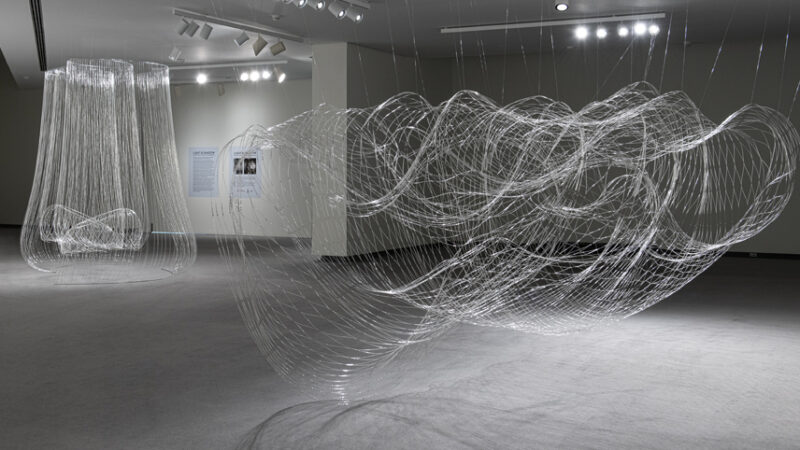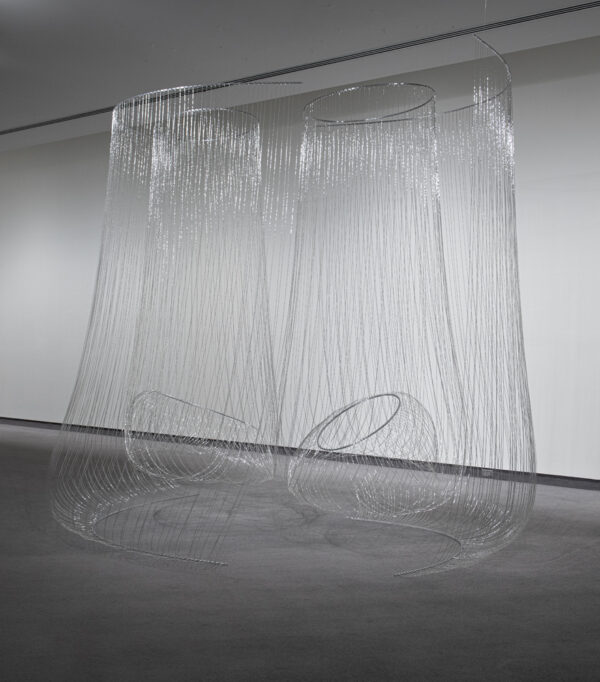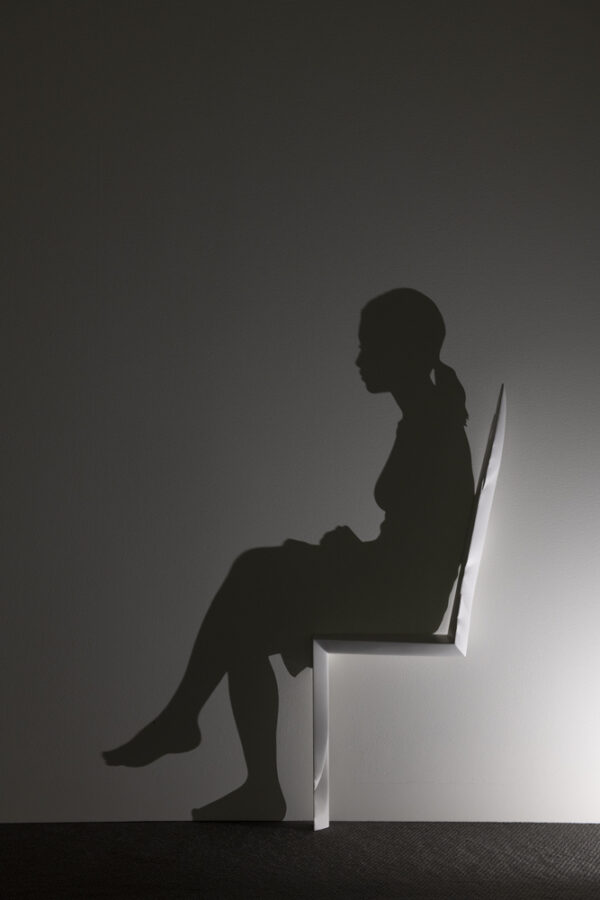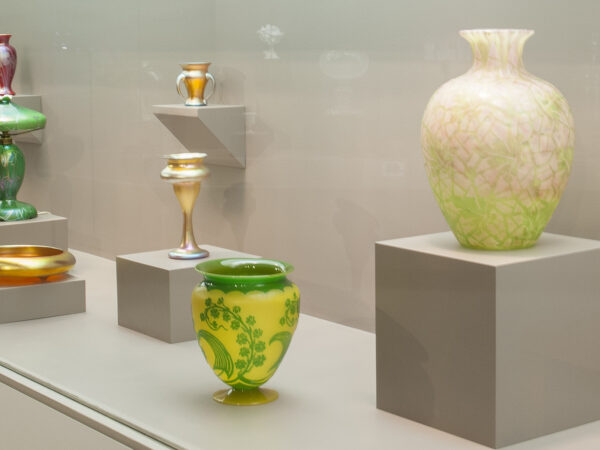
Light and Shadow: Alyson Shotz and Kumi Yamashita
August 3, 2019 - January 5, 2020
Louise and S. O. Beren Gallery
John W. and Mildred L. Graves Gallery
About This Exhibition
Light and Shadow: Alyson Shotz and Kumi Yamashita, features the work of two sculptors who create work of ethereal beauty.
Alyson Shotz strings silvered-glass beads on steel thread and hangs hernets and skeins in floor-to-ceiling installations. A critic remarked that her work “approaches invisibility.” In it, the solid materials of most sculptures are replaced by air and light. Kumi Yamashita presents ordinary objects that cast extraordinary shadows. Under raking light, a wall with a seemingly random scattering of wooden numbers yields a child’s monumental profile. A carved exclamation point casts a shadow of a question mark. A chair casts a shadow of a seated woman. Remove the light, and the art disappears.
Both artists create sculptures through labor-intensive handwork and trial-and error experimentation. They are each concerned with expanding bits of matter into large installations, the space-occuping potential of virtually weightless materials, and the variability and mystery of experience. In Light & Shadow, WAM is delighted to present Shotz and Yamashita’s awe-inspiring environments to Wichta.
The exhibition is guest curated by Vicki Halper, former curator of the Seattle Art Museum. Halper is no stranger to WAM. She curated Australian Glass Art, American Links, in summer 2014, and Cameo Glass in Contest: Charlotte Potter and April Surgent, in summer 2018.
ALYSON SHOTZ
One of two artists featured in the exhibition Light & Shadow, sculptor Alyson Shotz grapples with light, space, and gravity–elusive qualities of our physical world. What does it mean for space to expand? How is light captured? How will gravity affect what is created?
In Invariant Interval #3 and Equilibrium, nets of beaded wire, once packed into small creates, swell to room size–outlining pockets of air and changing shape to conform to different locations. Shotz says that she is “making sculptures that will contain space and allow it to be seen.” Gravity affects the drape and shape of her skeins. Light bursts and mutates from diferent viewing angles and light conditions, dematerializing or illuminatingn the structure. Color is present only as reflected in the glass. The artist considers that she is “redefining large-scale sculpture.”
Shotz was born in Arizona in 1964 and lives in Brooklyn, New York. She is a graduate of the Rhode Island School of Design and the University of Washington. Shotz has created large-scale installations for the Solomon R. Guggenheim Museum in New York and Stanford University’s Li Ka Shing Center for Learning and Knowledge, among many other places. Her work is in the permanent collection of the Solomon R. Guggenheim Museum, Crystal Bridges Museum of American Art, San Francisco Museum of Modern Art, and other leading museums. This exhibition of Shotz’s work–made from silvered-glass beads–is part of the Wichita Art Museum’s commitment to exhibiting groundbreaking contemporary glass art.
KUMI YAMASHITA
in 2008, Kumi Yamashita–labeled “The Magician of Shadow”–appeared on the Japanese TV show Unbelievable. Guests were asked to predict the shadows that would appear when her carved wood blocks were illuminated by a single light bulb. Fish? Alto Sax? Map? As the audience gasped, the profile of a young man, seeming both living and insubstantial, emerged from a scatter of intert matter. “The complete artowrk,” Yamashita writes, “is comprised of both the material (the solid objects) and the immaterial (the light or shadow).”
This sleight of hand is the result of painstaking manipulation of the solid objects and an artist who questions the reliability of fixed assumptions. For Yamashita, ugliness resides in stereotyping and rigid beliefs. Beauty resides in change. Shadows are beautiful in their mutability. They “reveal this extraordinary dimension where we see no borders, no races, no separation…only the essence of what we are.”
Yamashita, whose first name, Kumi, means “creating beauty,” was born in Takasaki, Japan, in 1968 and recently settled in Woodsstock, New York. In the years between, she has traveled, studied and worked worldwide, including undergraduate and graduate studies at cornish College of the Arts, Seattle, and the Glasgow School of Art, Scotland. She is uninterested in calling any one place home, and says, “i have always longed for a land that embraced all humanity and ideologies.” Yamashita’s work was featured this spring in the National Portrait Gallery exhibition, Black Out: Silhouettes Then and Now.
Light & Shadow: Alyson Shotz and Kumi Yamashita is a special loan exhibition organized by the Wichita Art Museum. The project is guest curated by Vicki Halper, former curator at the Seattle Art Museum with deep expertise in craft and glass art.

Alyson Shotz, Equilibrium, 2009. Stainless-steel wire, silvered-glass beads, and aluminum. 120 x 108 x 144 inches. Collection of the artist, Courtesy of Derek Eller Gallery, New York City

Kumi Yamashita, Chair, 2015. Enameled and carved wood, single light source, and shadow. 43 x 20 x 6 inches. Collection of Carl & Marilynn Thoma Art Foundation.
Our Generous Sponsors
This exhibition is generously supported by the F. Price Cossman Trust, INTRUST BANK, Trustee. The DeVore Foundation, Shaw Family Foundation, and Nancy and Bob Schwan are additional exhibition sponsors. All exhibitions are supported by the Friends of the Wichita Art Museum and City of Wichita.



